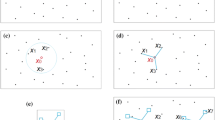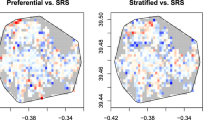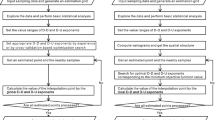Abstract
A common issue in spatial interpolation is the combination of data measured over different spatial supports. For example, information available for mapping disease risk typically includes point data (e.g. patients’ and controls’ residence) and aggregated data (e.g. socio-demographic and economic attributes recorded at the census track level). Similarly, soil measurements at discrete locations in the field are often supplemented with choropleth maps (e.g. soil or geological maps) that model the spatial distribution of soil attributes as the juxtaposition of polygons (areas) with constant values. This paper presents a general formulation of kriging that allows the combination of both point and areal data through the use of area-to-area, area-to-point, and point-to-point covariances in the kriging system. The procedure is illustrated using two data sets: (1) geological map and heavy metal concentrations recorded in the topsoil of the Swiss Jura, and (2) incidence rates of late-stage breast cancer diagnosis per census tract and location of patient residences for three counties in Michigan. In the second case, the kriging system includes an error variance term derived according to the binomial distribution to account for varying degree of reliability of incidence rates depending on the total number of cases recorded in those tracts. Except under the binomial kriging framework, area-and-point (AAP) kriging ensures the coherence of the prediction so that the average of interpolated values within each mapping unit is equal to the original areal datum. The relationships between binomial kriging, Poisson kriging, and indicator kriging are discussed under different scenarios for the population size and spatial support. Sensitivity analysis demonstrates the smaller smoothing and greater prediction accuracy of the new procedure over ordinary and traditional residual kriging based on the assumption that the local mean is constant within each mapping unit.
Similar content being viewed by others
References
Atteia O, Dubois J-P, Webster R (1994) Geostatistical analysis of soil contamination in the Swiss Jura. Environ Pollut 86:315–327
Barry J, Breen N (2005) The importance of place of residence in predicting late-stage diagnosis of breast or cervical cancer. Heal Place 11:15–29
Best NG, Richardson S, Thomson A (2005) A comparison of Bayesian spatial models for disease mapping. Stat Meth Med Res 14:35–59
Goovaerts P (1997) Geostatistics for natural resources evaluation. Oxford University Press, New York
Goovaerts P (2005) Geostatistical analysis of disease data: estimation of cancer mortality risk from empirical frequencies using Poisson kriging. Int J Heal Geogr 4:31. doi:10.1186/1476-072X-4-31
Goovaerts P (2007) Spatial uncertainty in medical geography: a geostatistical perspective. In: Shekhar S, Xiong H (eds) Encyclopedia of GIS. Springer, Berlin, pp 1106–1112
Goovaerts P (2008) Kriging and semivariogram deconvolution in presence of irregular geographical units. Math Geosci 40:101–128
Goovaerts P (2009a) Combining area-based and individual-level data in the geostatistical mapping of late-stage cancer incidence. Spat Spatio-tempor Epidemiol 1:61–71
Goovaerts P (2009b) Medical geography: a promising field of application for geostatistics. Math Geosci 41:243–264
Goovaerts P (2010) A coherent geostatistical framework for combining choropleth map and field data in the spatial interpolation of soil properties. Eur J Soil Sci (accepted)
Goovaerts P, Journel AG (1995) Integrating soil map information in modeling the spatial variation of continuous soil properties. Eur J Soil Sci 46:397–414
Gotway CA, Young LJ (2002) Combining incompatible spatial data. J Am Stat Assoc 97(459):632–648
Gotway CA, Young LJ (2005) Change of support: an interdisciplinary challenge. In: Renard Ph, Demougeot-Renard H, Froidevaux R (eds) geoENV V—Geostatistics for environmental applications. Springer, Berlin, pp 1–13
Gotway CA, Young LJ (2007) A geostatistical approach to linking geographically-aggregated data from different sources. J Comput Graph Stat 16(1):115–135
Hengl T, Heuvelink GBM, Stein A (2004) A generic framework for spatial prediction of soil variables based on regression-kriging. Geoderma 120:75–93
Journel AG (1983) Nonparametric estimation of spatial distributions. Math Geol 15(3):445–468
Journel AG, Huijbregts CJ (1978) Mining geostatistics. Academic Press, London
Kerry R, Goovaerts P, Haining V, Ceccato RP (2010a) Applying geostatistical analysis to crime data: car-related thefts in the Baltic States. Geogr Anal 42:53–75
Kerry R, Rawlins BG, Goovaerts P (2010b) Area-to-point kriging of organic carbon and soil texture: an efficient use of legacy soil data from polygon maps for regional or national scale digital soil mapping. In: Proceedings of 4th global workshop on digital soil mapping, Rome, Italy, May 24–26, 2010
Kyriakidis P (2004) A geostatistical framework for area-to-point spatial interpolation. Geogr Anal 36(2):259–289
Liu Y, Journel AG (2009) A package for geostatistical integration of coarse and fine scale data. Comput Geosci 35(3):527–547
Liu TL, Juang KW, Lee DY (2006) Interpolating soil properties using kriging combined with categorical information of soil maps. Soil Sci Soc Am J 70:1200–1209
Oliver MA, Webster R, Lajaunie C, Muir KR, Parkes SE, Cameron AH, Stevens MCG, Mann JR (1998) Binomial co-kriging for estimating and mapping the risk of childhood cancer. IMA J Math Appl Med 15(3):279–297
Rushton G, Peleg I, Banerjee A, Smith G, West M (2004) Analyzing geographic patterns of disease incidence: Rates of late-stage colorectal cancer in Iowa. J Med Syst 28(3):223–236
Talbot TO, Kulldorff M, Forand SP, Haley VB (2000) Evaluation of spatial filters to create smoothed maps of health data. Stat Med 19:2399–2408
Wackernagel H (1998) Multivariate geostatistics. Springer, Berlin. 2nd completely revised edition
Walker E, Monestiez P, Renard D, Bez N (2008) Kriging of the latent probability of a binomial variable: application to fish statistics. In: Ortiz J, Emery X (eds) Geostatistics 2008. GECAMIN, Santiago, pp 981–990
Waller LA, Gotway CA (2004) Applied spatial statistics for public health data. Wiley, New Jersey
Webster R, Oliver MA, Muir KR, Mann JR (1994a) Kriging the local risk of a rare disease from a register of diagnoses. Geogr Anal 26:168–185
Webster R, Atteia O, Dubois J-P (1994b) Co-regionalization of trace metals in the soil in the Swiss Jura. Eur J Soil Sci 45:205–18
Young JL Jr, Roffers SD, Ries LAG, Fritz AG, Hurlbut AA (eds) (2001) SEER summary staging manual—2000: codes and coding instructions, National Cancer Institute. National Institutes of Health Pub # 01-4969, Bethesda, MD
Author information
Authors and Affiliations
Corresponding author
Rights and permissions
About this article
Cite this article
Goovaerts, P. Combining Areal and Point Data in Geostatistical Interpolation: Applications to Soil Science and Medical Geography. Math Geosci 42, 535–554 (2010). https://doi.org/10.1007/s11004-010-9286-5
Received:
Accepted:
Published:
Issue Date:
DOI: https://doi.org/10.1007/s11004-010-9286-5




